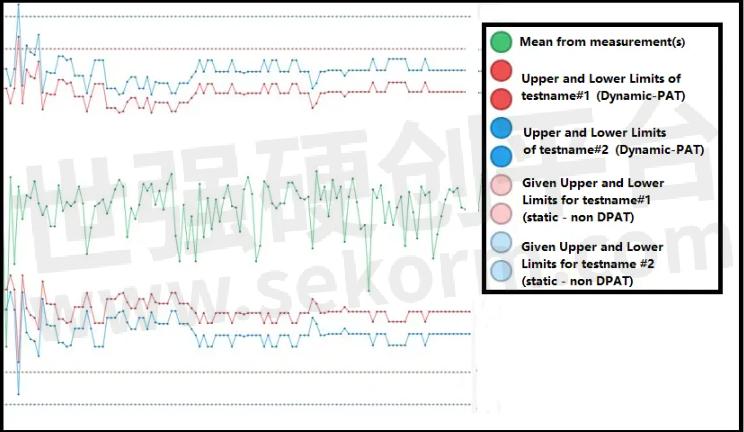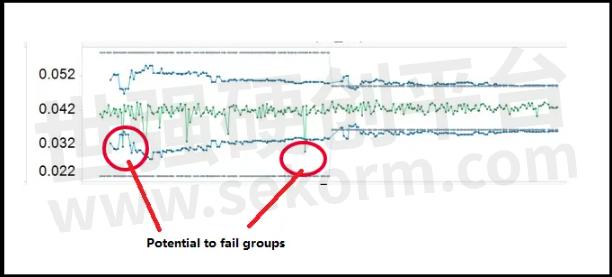PMA‘s DPAT Implementation Safeguards Against Potential Yield Losses

DPAT, also known as Dynamic Part Average Testing, is used by the Automotive industry to control their parts manufacturing. With the advent of Electric vehicles (EVs), there is an increasing number of requests for incorporating DPAT into Keysight’s PathWave Manufacturing Analytics (PMA) Dashboard for a more precise calculation of what to discard as fails and what to pass and ship out to end user.
The Automotive Electronics Council (AEC) has described DPAT in their AECQ-100 standard as an outlier detection method mostly applied to automotive devices that must be qualified and tested to meet strict requirements. Along with its family of other standards in AECQ-100, DPAT detects outliers using statistical methods to predict items that are likely to fail in the near future but still considered passing within the static upper and lower limits given as the item's specifications.

Figure 1. Dynamic PAT in action
Principles of DPAT
DPAT is derived initially from the idea of its predecessor Part Average Test (PAT). PAT is originally intended to have a stricter quality with a narrower passing range, resulting in higher quality products at the expense of a higher rejection rate. From Figure 2 below, more Device Under Test (DUT)s will fall under the outliers range and be considered as Fails.

Figure 2. Using PAT to increase the quality at the expense of a higher rejection rate
Over time, the automotive industry decided to further improve the quality of their output by introducing DPAT. What DPAT does is that it uses the measurement value to continuously calculate the mean value, resulting in a non-constant mean that makes the upper and lower limits dynamically change according in real-time.
With DPAT coming into the picture, the manufacturer can see from the chart in real-time what falls under the outlier group of items and predict what is likely to fail next, and make adjustments and fixes to increase their yield. Instead of mindlessly rejecting items that fall under the outlier range, the manufacturer can increase their yield by “saving” the potential yield losses by acting toward them.
In Figure 3, notice the PAT (blue lines) calculated dynamically. The outliers group (in red circles) no longer sits static and waits to be rejected; instead, it is used as a prediction indicator for failed items for the upcoming DUTs.

Figure 3. DPAT introduces its dynamic PAT limits (in blue) and makes the outliers as future predictions for failures.
Applications of DPAT in PMA
PMA has helped one of its automotive manufacturer users to increase the yield of their sensor product by using the DPAT module. The logs provide live measurement to PMA, and it uses it to calculate the PAT dynamically and feed it back to its testers in real-time. This customer has been using PMA to improve their production for over 2 years and will continue using Keysight’s PMA in the future.
Below is the flowchart of how the limits are calculated and how PMA gathers this feedback into the system. Keysight follows the standards recommended by AEC-Q001, 2001 (in addition to our additional algorithm). Refer to Figure 4 below:

Figure 4. Standards of DPAT being calculated in PMA and feedback live to the system (following AEC-Q001, 2001 standards)
Conclusions
In conclusion, the implementation of DPAT in PMA offers manufacturers a valuable advantage in optimizing their production process. By utilizing real-time data and analyzing charts to identify outlier items, manufacturers can proactively predict potential failures and take necessary actions to enhance yield and save potential yield losses by making targeted adjustments and fixes.
About PMA
PathWave Manufacturing Analytics (PMA) is backed by an experienced team of people at Keysight, who can help you achieve the goal of bringing in data from your manufacturing test equipment and software for analysis and presentation to help you gain the necessary actionable insights that can be used from an operator on the line to the highest senior management levels of the business organization. PMA includes a scalable architecture that can grow with your business. It comes with regular software updates that will allow you to manage the changing business or production requirements in your environment. PMA will free up engineering and development teams to work on the software and tools that are valuable to your manufacturing lines and business, as well as save time on the production floor with its actionable insights.
- +1 Like
- Add to Favorites
Recommend
- Loading data into PathWave Manufacturing Analytics
- Reducing Retest Improves First Pass Yield (FPY) with PathWave Manufacturing Analytics
- Boosting Your Manufacturing Analytics System with Keysight’s Pathwave Manufacturing Analytics (PMA)
- PathWave Manufacturing Analytics (PMA) Use Case: Faster diagnostics for Semiconductor recalls
- Keysight‘s Production Data Analytics Software PWA Has Supported Cloud Service Operations and Software
- Keysight i7090 with PathWave Test Executive for Manufacturing
- Testing LED using PathWave Test Executive for Manufacturing
- Keysight PathWave System Design 2023 Software Accelerates RF System Design and Digital Mission Engineering Workflows for 5G Non-Terrestrial Networks
This document is provided by Sekorm Platform for VIP exclusive service. The copyright is owned by Sekorm. Without authorization, any medias, websites or individual are not allowed to reprint. When authorizing the reprint, the link of www.sekorm.com must be indicated.















































































































































































































































































































































































































































































































































































































































































































































































































































